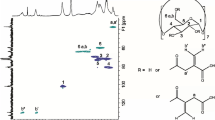Abstract
Albendazole, an effective broad-spectrum anthelmintic agent, showed unpredictable therapeutic response caused by poor water solubility and slow dissolution rate. Then, novel binary and multicomponent supramolecular systems of two different solid forms of albendazole (I and II) with maltodextrin alone or with glutamic acid were studied as an alternative to improve the oral bioavailability of albendazole. The interactions and effects on the properties of albendazole were studied in solution and solid state. The solid systems were characterized using Raman and Fourier transform-infrared spectroscopy, thermal analysis, powder X-ray diffraction, and scanning electron microscopy. The solubility measurements, performed in aqueous and simulated gastric fluid, showed that albendazole (form II) was the most soluble form, while its supramolecular systems showed the highest solubility in simulated gastric fluid. On the other hand, the dissolution profiles of binary and multicomponent systems in simulated gastric fluid displayed pronounced increments of the dissolved drug and a faster dissolution rate compared to those of free albendazole forms. Thus, these supramolecular structures constitute an interesting alternative to improve the physicochemical properties of albendazole, with potential application for the preparation of pharmaceutical oral formulations.







Similar content being viewed by others
References
Bauer JF. Polymorphism: a critical consideration in pharmaceutical development, manufacturing and stability. J Technol. 2008;15–23.
Brittain HG. Polymorphism and solvatomorphism 2010. J Pharm Sci. 2012;101(2):464–84. https://doi.org/10.1002/jps.22788.
Flórez J. Fármacos antiparasitarios. II. Helmintos y artrópodos. In: Farmacología Humana. Barcelona: Masson S.A.; 1998. p. 1239–47.
Barrera MG, Leonardi D, Bolmaro RE, Echenique CG, Olivieri AC, Salomon CJ, et al. In vivo evaluation of albendazole microspheres for the treatment of Toxocara canis larva migrans. Eur J Pharm Biopharm. 2010;75(3):451–4. https://doi.org/10.1016/j.ejpb.2010.03.017.
García A, Barrera MG, Piccirilli G, Vasconi MD, Di Masso RJ, Leonardi D, et al. Novel albendazole formulations given during the intestinal phase of Trichinella spiralis infection reduce effectively parasitic muscle burden in mice. Parasitol Int. 2013;62(6):568–70. https://doi.org/10.1016/j.parint.2013.08.009.
Solomon N, Kachani M, Zeyhle E, Macpherson CNL. The natural history of cystic echinococcosis in untreated and albendazole treated patients. Acta Trop. 2017;171:52–7. https://doi.org/10.1016/j.actatropica.2017.03.018.
Chattah AK, Zhang R, Mroue KH, Pfund LY, Longhi MR, Ramamoorthy A, et al. Investigating albendazole desmotropes by solid-state NMR spectroscopy. Mol Pharm. 2015;12(3):731–41. https://doi.org/10.1021/mp500539g.
Pranzo MB, Cruickshank D, Coruzzi M, Caira MR, Bettini R. Enantiotropically related albendazole polymorphs. J Pharm Sci. 2010;99(9):3731–42. https://doi.org/10.1002/jps.22072.
Martinez L, Lamprou DA, McBurney RT, Halbert GW. A novel hot-melt extrusion formulation of albendazole for increasing dissolution properties. Int J Pharm. 2016;499(1-2):175–85. https://doi.org/10.1016/j.ijpharm.2016.01.006.
Priotti J, Codina AV, Leonardi D, Vasconi MD, Hinrichsen LI, Lamas MC. Albendazole microcrystal formulations based on chitosan and cellulose derivatives: physicochemical characterization and in vitro parasiticidal activity in Trichinella spiralis adult worms. AAPS PharmSciTech. 2017;18(4):947–56. https://doi.org/10.1208/s12249-016-0659-z.
Pradines B, Gallard JF, Iorga BI, Gueutin C, Loiseau PM, Ponchel G, et al. Investigation of the complexation of albendazole with cyclodextrins for the design of new antiparasitic formulations. Carbohydr Res. 2014;398:50–5. https://doi.org/10.1016/j.carres.2014.06.008.
Chattah AK, Pfund LY, Zoppi A, Longhi MR, Garnero C. Toward novel antiparasitic formulations: complexes of albendazole desmotropes and β-cyclodextrin. Carbohydr Polym. 2017;164:379–85. https://doi.org/10.1016/j.carbpol.2017.01.098.
Gurrapu A, Jukanti R, Bobbala SR, Kanuganti S, Jeevana JB. Improved oral delivery of valsartan from maltodextrin based proniosome powders. Adv Powder Technol. 2012;23(5):583–90. https://doi.org/10.1016/j.apt.2011.06.005.
Ku R, Sahoo N, Arijit Guha B, Sahoo N, Kuotsu K. Development and in vitro/in vivo evaluation of controlled release provesicles of a nateglinide maltodextrin complex. Acta Pharma Sin B. 2014;4(5):408–16.
Zhang J, Zhang X, Wang X, Huang Y, Yang B, Pan X, et al. The influence of maltodextrin on the physicochemical properties and stabilization of beta-carotene emulsions. AAPS PharmSciTech. 2017;18(3):821–8. https://doi.org/10.1208/s12249-016-0572-5.
Aiassa V, Zoppi A, Albesa I, Longhi MR. Inclusion complexes of chloramphenicol with β-cyclodextrin and aminoacids as a way to increase drug solubility and modulate Ros production. Carbohydr Polym. 2014;121:320–7. https://doi.org/10.1016/j.carbpol.2014.11.017.
Granero GE, Maitre MM, Garnero C, Longhi MR. Synthesis, characterization and in vitro release studies of a new acetazolamide–HP-β-CD–TEA inclusion complex. Eur J Med Chem. 2008;43(3):464–70. https://doi.org/10.1016/j.ejmech.2007.03.037.
Aiassa V, Zoppi A, Albesa I, Longhi MR. Inclusion complexes of chloramphenicol with β-cyclodextrin and aminoacids as a way to increase drug solubility and modulate ROS production. Carbohyd Pol. 2015;121:320–7. https://doi.org/10.1016/j.carbpol.2014.11.017.
Mura P, Maestrelli F, Cirri M. Ternary systems of naproxen with hydroxypropyl-β-cyclodextrin and aminoacids. Int J Pharm. 2003;260(2):293–302. https://doi.org/10.1016/S0378-5173(03)00265-5.
Higuchi T, Connors KA. Phase-solubility techniques in advances. In: Analytical chemistry and instrumentation, vol. 4. New York: Interscience; 1965. p. 117–212.
Moore WJ, Flanner HH. Mathematical comparison of dissolution profiles. Pharm Technol. 1996;20:64–74.
Costa P. An alternative method to the evaluation of similarity factor in dissolution testing. Int J Pharm. 2001;220(1-2):77–83. https://doi.org/10.1016/S0378-5173(01)00651-2.
Garnero C, Aloisio M, Longhi M. Ibuprofen-maltodextrin interaction: study of enantiomeric recognition and complex characterization. Pharmacol Pharm. 2013;4(01):18–30. https://doi.org/10.4236/pp.2013.41003.
Lindenberg M, Kopp S, Dressman JB. Classification of orally administered drugs on the World Health Organization model list of essential medicines according to the biopharmaceutics classification system. Eur J Pharm Biopharm. 2004;58(2):265–78. https://doi.org/10.1016/j.ejpb.2004.03.001.
Acknowledgments
Authors wish to acknowledge the assistance of the Consejo Nacional de Investigaciones Científicas y Técnicas (CONICET) and the Universidad Nacional de Córdoba, both of which provided support and facilities for this investigation. Also, project MinCyT-CONICET-CAPES is gratefully acknowledged.
Funding
The authors thank the Fondo para la Investigación Científica y Tecnológica (FONCYT) [Préstamo BID PICT 2013-0504], the Secretaría de Ciencia y Técnica de la Universidad Nacional de Córdoba (SECyT), and the Brazilian National Council for Scientific and Technological Development (CNPQ) for financial support.
Author information
Authors and Affiliations
Corresponding author
Electronic Supplementary Material
ESM 1
(DOCX 117 kb)
Rights and permissions
About this article
Cite this article
Bongioanni, A., Araújo, B.S., de Oliveira, Y.S. et al. Improving Properties of Albendazole Desmotropes by Supramolecular Systems with Maltodextrin and Glutamic Acid. AAPS PharmSciTech 19, 1468–1476 (2018). https://doi.org/10.1208/s12249-018-0952-0
Received:
Accepted:
Published:
Issue Date:
DOI: https://doi.org/10.1208/s12249-018-0952-0




